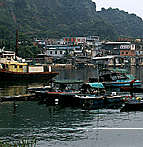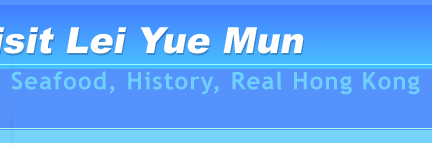Lei Yue Mun Historic Attractions Guide 2025: Lighthouse, Tin Hau Temple & Cultural Heritage
Lei Yue Mun's rich history extends far beyond its famous seafood, encompassing centuries of maritime heritage, spiritual traditions, and strategic importance in Hong Kong's development. This comprehensive guide explores the area's historic attractions that provide visitors with authentic cultural experiences and stunning harbor views, connecting travelers with Hong Kong's authentic maritime culture through preserved landmarks and living traditions.
From the iconic Lei Yue Mun Lighthouse that has guided ships through Victoria Harbour for over a century to the centuries-old Tin Hau Temple that serves as the spiritual heart of the fishing community, these historic sites offer visitors insight into Hong Kong's authentic cultural heritage while providing spectacular photography opportunities and educational experiences that complement the area's renowned culinary attractions.
Lei Yue Mun Lighthouse - Maritime Heritage Icon
The Lei Yue Mun Lighthouse stands as one of Hong Kong's most important maritime landmarks, serving as a crucial navigation aid for ships entering Victoria Harbour for over a century. Built in 1902 during the height of Hong Kong's development as a major international port, the lighthouse represents the technological achievement and maritime expertise that established Hong Kong as a global shipping hub connecting East and West through one of the world's busiest harbors.
Visiting the Lighthouse
Access and Location: The lighthouse grounds are accessible to the public during daylight hours, located at the eastern tip of the Lei Yue Mun waterfront area approximately five minutes' walk from the main seafood restaurant district. The well-maintained pathways provide safe access to viewing areas around the lighthouse, with protective barriers ensuring visitor safety while allowing close observation of the historic structure and surrounding harbor views.
Photography and Scenic Views: The lighthouse area provides exceptional photography opportunities with 360-degree harbor views that capture both the historic structure and the dynamic modern skyline of Hong Kong Island across the water. The elevated position offers unobstructed views of ship traffic, harbor activities, and the iconic Hong Kong skyline, making it a premier destination for both sunset photography and maritime observation.
Tin Hau Temple - Spiritual Heart of Lei Yue Mun
The Lei Yue Mun Tin Hau Temple represents one of Hong Kong's most authentic and continuously operating temples dedicated to the sea goddess Tin Hau (Mazu), serving as the spiritual center for the local fishing community for over 270 years. Built in 1753 during the Qing Dynasty, this Grade III historic building has provided protection and blessings for countless fishermen and seafarers who depend on the sea for their livelihood, maintaining traditional Chinese maritime religious practices in an increasingly modern urban environment.
Cultural and Historical Context: The temple's founding during the 18th century reflects the establishment of Lei Yue Mun as a significant fishing community, with the temple serving as both a religious center and community gathering place for village festivals, ceremonies, and social activities. The temple's continuous operation through centuries of political and social changes demonstrates the enduring importance of traditional spiritual practices in Hong Kong's maritime communities.
Temple Traditions and Visiting Guidelines
Religious Practices and Festivals: The temple hosts traditional Chinese festivals throughout the year, with the annual Tin Hau Festival (typically in April or May according to the lunar calendar) representing the most significant celebration featuring Cantonese opera performances, lion dances, and community feasts that attract thousands of participants and visitors. Daily worship practices include morning and evening prayer sessions where local residents and fishermen offer incense and prayers for safety and prosperity.
Cultural Etiquette for Visitors: Respectful temple visits require modest dress covering shoulders and knees, quiet behavior during prayer sessions, and understanding of traditional customs such as proper incense offering procedures. Photography is generally permitted in most areas, but visitors should ask permission before photographing worshippers or ceremonial activities, and flash photography should be avoided during active religious ceremonies to maintain the sacred atmosphere.
Hong Kong Museum of the War of Resistance and Coastal Defence - Military Heritage
Located on Hong Kong Island directly across from Lei Yue Mun village, the Hong Kong Museum of the War of Resistance and Coastal Defence (renamed from the Hong Kong Museum of Coastal Defence in September 2024) is housed within the historic Lei Yue Mun Fort built in 1887. This exceptional museum provides comprehensive insights into Hong Kong's military heritage and strategic importance, covering 600 years of coastal defense history through professional exhibits and preserved military installations.
Historical Significance: The fort served as a crucial defensive position protecting the eastern approach to Victoria Harbour, with commanding views of the shipping channels and harbor entrance. The museum conversion preserves original military architecture including underground tunnels, artillery positions, and defensive structures while providing educational context about Hong Kong's role in regional conflicts and maritime security.
Museum Exhibitions and Visiting Information
Exhibition Coverage: The museum chronicles Hong Kong's military history from ancient coastal defenses through modern conflicts, featuring interactive displays, original artifacts, and educational materials suitable for visitors of all ages. The comprehensive timeline covers the Ming Dynasty coastal defenses, British colonial military development, World War II experiences, and contemporary security arrangements.
Current Status: Please note that the museum may be closed for renovation work - visitors should verify current operational status before planning visits. When operational, the museum typically offers free admission and guided tours for groups with advance reservations.
Access: The museum is accessible by ferry from Lei Yue Mun or taxi from Hong Kong Island locations. The ferry connection provides scenic harbor views while approaching the historic fort location, adding to the overall cultural experience.
Old Lei Yue Mun Quarry - Industrial Heritage
The abandoned Lei Yue Mun Quarry represents Hong Kong's industrial heritage, showcasing the granite extraction industry that contributed materials for major construction projects during Hong Kong's development boom. Now transformed into a unique geological attraction and recreational area, the quarry offers educational opportunities about Hong Kong's industrial history while providing dramatic landscape photography opportunities.
Geological and Historical Features
Industrial Heritage: The quarry operated during Hong Kong's rapid urban development, supplying granite for major construction projects including infrastructure and building development throughout the territory. The quarry's economic importance made it a significant employer and economic contributor to the Lei Yue Mun community during the 20th century.
Current Attractions: The rehabilitated quarry features exposed granite formations that provide educational opportunities about Hong Kong's geological composition, walking trails through the former mining areas, and elevated viewing platforms for landscape photography. The dramatic rock formations and seasonal golden reed fields create unique scenic opportunities, particularly during autumn months.
Practical Visitor Planning for Historic Attractions
Combined Attraction Itineraries
Half-Day Cultural Tour (3-4 hours): Begin with the Tin Hau Temple for cultural orientation, followed by lighthouse exploration for harbor views and photography, then quarry visit for geological education and landscape scenery. This combination provides comprehensive exposure to Lei Yue Mun's cultural, maritime, and industrial heritage.
Full-Day Heritage Experience: Combine Lei Yue Mun historic attractions with the Museum of the War of Resistance and Coastal Defence (when operational) via ferry crossing for complete military and civilian heritage coverage. This extended itinerary provides thorough understanding of Hong Kong's historical development and strategic importance.
Transportation and Access
Internal Connections: Lei Yue Mun's historic attractions are within walking distance of each other, with the lighthouse approximately five minutes from the temple, and the quarry reachable via designated trails. Clear signage and maintained pathways connect all major sites while providing scenic harbor views throughout the walking routes.
Best Visiting Times: Morning visits provide optimal lighting for photography and comfortable walking conditions, while late afternoon offers spectacular sunset photography opportunities from the lighthouse area. Cultural activities at the temple are most active during morning prayer sessions and major festival periods.
This comprehensive guide to Lei Yue Mun's historic attractions demonstrates the area's significance beyond culinary tourism, providing visitors with authentic cultural experiences that showcase Hong Kong's maritime heritage, spiritual traditions, and historical development while maintaining connections to living community practices and contemporary cultural preservation efforts.
Lei Yue Mun - The Definitive Guide - Gett here - Seafood Bazaar - Dining - Fishing Village









